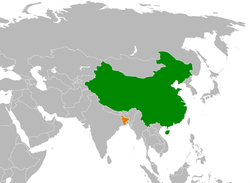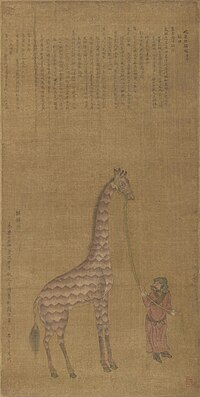Bangladesh–China relations
 | |
China |
Bangladesh |
|---|---|
Diplomatic relations between Bangladesh and the People's Republic of China were established in 1975, four years after Bangladesh gained independence. Historically, relations include over two thousand years of cultural and political interactions between China and the Bengal region. The present-day Sino-Bangladesh relationship is characterized by close political, economic and military ties.[1]
History
Early history
Bangladesh and China have a rich heritage of cultural interactions and trade which developed on the south-west silk route, the ancient tea route and the maritime silk road.

Chinese monks, scholars and traders of the Qin Dynasty, visited the ancient Vedic kingdom of Pundravardhana, located in present-day Bogra and Rangpur, as early as the 2nd century BCE, by travelling across the south-west Silk Road.[2] Between the 5th and 7th centuries, many Chinese monks such as Yijing and Xuanzang, traveled to the Buddhist monasteries of northern Bangladesh, seeking knowledge of the "Western Heaven" (Indian subcontinent). Atish Dipankar Srigana, a Buddhist master from Bikrampur, traveled to Tibet in the 8th century and established the Sarma schools of Tibetan Buddhism.[2]
Relations flourished during the Early Bengal Sultanate. After Ghiyasuddin Azam Shah sent the first embassies to China, the Ming Dynasty and the eastern subcontinent enjoyed a century of trade on the maritime silk route. Emperor Yongle, in particular, sent annual envoys to Bengal.[2]

Chinese explorer Admiral Zheng He undertook at least two, and according to some four, voyages to Bengal. An excerpt from the journals of the time describes the journey to Sonargaon -
"We started from the Kingdom of Sumatra, sailed with the wind for twenty days and anchored in Chittagong. From there we took small boats for over 500 li (250 kilometers) to Sonargaon....There was a guard of honor of thousands of people accompanying us along the way....
The Sultan's palace was tall and spacious with pillars in the color of brass and decorated with flower and animal carvings. There were long corridors on both sides with thousands of armed cavalry squads inside and extraordinarily strong and dignified soldiers equipped with swords, bows and arrows outside. On the left and right of vermilion steps leading up to the palace there were over a hundred parasols made of peacock feathers. Hundreds of elephant squads lined up in front of the palace. The Sultan wore a crown studded with eight gems and sat on the throne with a sword on his knees. Two men with silver staffs came and guided the emperor's envoy forward....
The locals are followers of Islam. They are honest and pure and speak a language called Bengali. Some men wrap their foreheads in white cloth and wear long white shirts. Some others are wrapped in colorful cloth from the waist down. Women are dressed in short shirts and draped with brocades....
The kingdom is densely populated and has abundant resources and fertile lands. Hard-working men plough the fields while diligent women weave cloth. Many of the rich build ships and go abroad for business...."
20th century
Chinese premier Zhou Enlai visited East Pakistan several times in the 1950s and 60s. The Chinese Communist Party maintained close ties with Bengali nationalist leaders Maulana Abdul Hamid Khan Bhashani and Huseyn Shaheed Suhrawardy. Bhashani in particular, was considered close to Mao Zedong. While serving as the Prime Minister of Pakistan in 1957, Awami League president Huseyn Shaheed Suhrawardy became the first Pakistani leader to pay a state visit to the PRC.
Diplomatic relations
During the Bangladesh Liberation War in 1971, China supported Pakistan against the Mukti Bahini. The Bengali independence movement conflicted with the PRC's strategic interests at the time, as its close ally Pakistan mediated in the diplomatic reapproachment between China and the United States. In the years immediately following independence, Bangladesh was also close to India and the Soviet Union, considered by China as adversaries. In 1972, China exercised its veto power as a permanent member of the UN Security Council to block Bangladesh's entry into the United Nations. However, by 1974 China and Bangladesh began developing formal relations.[3]
After the assassination of Sheikh Mujibur Rahman in August 1975, the military regime that assumed power began distancing Bangladesh from India and the Soviet Union. Diplomatic relations with China were established in January 1976. Growing public anger at India's unilateral moves to construct the Farakka Barrage and divert waters of the Ganges, led the new regime in Bangladesh to look to China for strategically balancing the country's position in the region. In 1977, military ruler General Ziaur Rahman made an official visit to the PRC.[3] Successive governments in Bangladesh followed the policy of building close relations with China.
By the mid-1980s, China had forged close commercial and cultural ties with Bangladesh and also supplied it with military aid and equipment.[3] The then-president of Bangladesh Hossain Mohammad Ershad was received with much fanfare and warmth when he visited Beijing in July 1987. A Bangladesh-China friendship bridge was constructed and inaugurated over river Buriganga connecting Dhaka-Munshigonj by the Chinese as token of this newly advancing diplomatic and military relationship. On October 4, 2000, Ministry of Post and Telecommunications (Bangladesh) issued a postal stamp marking the 25th anniversary of the establishment of Bangladesh-China diplomatic relations. By this time, China had provided economic assistance totaling US$ 217 million to Bangladesh and the bilateral trade had reached a value mounting to USD 715 million dollars.[4] In 2002, the Chinese Premier Wen Jiabao made an official visit to Bangladesh and both countries declared 2005 as the "Bangladesh-China Friendship Year."[5] The two countries signed nine different bi-lateral agreements to increase there mutual relationship.[6]
On Bangladeshi invitation China was added as an observer in the South Asian Association for Regional Cooperation (SAARC).[7] After Cyclone Sidr hit Bangladesh in 2007, China donated US$ 1 million for relief and reconstruction in cyclone-hit areas.[8]
Economic relations
Bangladesh is third largest trade partner of China in South Asia. But, the bilateral trade between them is highly tilted in favor of Beijing.[9] Bilateral trade reached as high as USD 3.19 billion in 2006, reflecting a growth of 28.5% between 2005 and 2006. China has bolstered its economic aid to Bangladesh to address concerns of trade imbalance; in 2006, Bangladesh's exports to China amounted only about USD 98.8 million.[10] Under the auspices of the Asia-Pacific Free Trade Agreement (AFTA), China removed tariff barriers to 84 types of commodities imported from Bangladesh and is working to reduce tariffs over the trade of jute and textiles, which are Bangladesh's chief domestic products.[10] China has also offered to construct nuclear power plants in Bangladesh to help meet the country's growing energy needs, while also seeking to aid the development of Bangladesh's natural gas resources.[11] [12] China's mainly imports raw materials from Bangladesh like leather, cotton textiles, fish, etc. China's major exports to Bangladesh include textiles, machinery and electronic products, cement, fertilizer, tyre, raw silk, maize, etc.[13]
In 2005, Chinese premier Wen Jiabao visited Bangladesh on an official visit on April 7 and 8. Various agreements were signed during this visit. On transportation side, China and Bangladesh have agreed to start a direct air transport route between Dhaka and Beijing via Kunming. Also Kunming-Chittagong road link through Myanmar is also considered.[9] The Chinese premier readily agreed to constructing the Di-Aluminium Phosphate (DAP) fertilizer factory in Chittagong entirely on concessional lending instead of on supplier's credit.[14]
In 2007, Chinese Assistant Minister of Commerce, Wang Chao visited Bangladesh with the 39-member purchase delegation. It is the biggest purchase delegation ever to Bangladesh with over 10 companies listed in China's top 500 and some of them in world's top 500. Delegation is reported to have purchased Bangladeshi goods worth over USD $50 million.[15] Both countries accepted to build a "Bangladesh-China Friendship Exhibition Center" in Dhaka.[15]
Bangladesh's relationship with China has historically affected India in one way or another. In 2007, news reports claimed that China was planning to divert the water of Brahmaputra river to its north-west regions. The Prime Minister of India Manmohan Singh met Chinese president Hu Jintao to schedule the first meeting on this matter. Adding to India's voice was Bangladesh, which would be deeply affected if China were to actually go ahead with its plans.[16]
Military relations
The Bangladesh Army has been equipped with Chinese tanks, its navy has Chinese frigates and missile boats and the Bangladesh Air Force flies Chinese fighter jets. In 2002, China and Bangladesh signed a “Defence Cooperation Agreement” which covers military training and defence production. In 2006, in a report submitted to the United Nations by China, for its exports and imports of major conventional arms revealed Dhaka is emerging as a major buyer of weapons made in China. China sold 65 large caliber artillery systems, 16 combat aircraft and 114 missile and related equipment to Bangladesh in 2005. Besides this, some 200 small arms like pistols and sub-machine guns have also been imported along with regular 82-mm mortars.[17]
In 2008, Bangladesh set up an anti-ship missile launch pad near the Chittagong Port with assistance from China. The maiden missile test was performed on May 12, 2008 with active participation of Chinese experts. It successfully test-fired anti-ship missile C-802A with a strike range of 120 km from the frigate BNS Osman near Kutubdia Island in the Bay of Bengal. BNS Osman which was commissioned in 1989, is a 1500-ton Chinese built Jianghu class Frigate, and the C-802A missile is a modified version of Chinese Ying Ji-802 with weight reduced from 815 kg to 715 kg in order to increase the strike range from 42 km to 120 km.
See also
References
- ^ http://www.thedailystar.net/newDesign/news-details.php?nid=242607
- ^ a b c d http://www.fmprc.gov.cn/eng/wjb/zwjg/zwbd/t756682.htm
- ^ a b c Bangladesh - China and Other Asian Nations
- ^ "Dhaka Issues Memorial Stamps on Bangladesh-China Diplomatic Relationship". People's Daily. October 4, 2000. Retrieved 2008-09-15.
- ^ "Bangladesh-China" Friendship Year
- ^ "Bangladesh, China sign nine agreements". The Hindu. April 9, 2005. Archived from the original on 24 September 2008. Retrieved 2008-09-15.
{{cite news}}:|first=missing|last=(help); Unknown parameter|deadurl=ignored (|url-status=suggested) (help) - ^ "China pledges to further promote China-Bangladesh ties". Xinhua. June 7, 2006. Retrieved 2008-09-15.
- ^ "China donates US$1 mln to Bangladesh". CCTV. 2007-11-21. Retrieved 2008-09-15.
- ^ a b "Changing Dynamics of Sino-Bangladesh Relations". southasiaanalysis group. 21. 04. 2005. Retrieved 2008-09-15.
{{cite news}}:|first=missing|last=(help); Check date values in:|date=(help) - ^ a b China grants over USD 10 million aid to Bangladesh
- ^ China's March on South Asia
- ^ China keen to build Rooppur nuclear plant
- ^ "China and Bangladesh". The Department of Asian Affairs, People's Republic of China. The Department of Asian Affairs, People's Republic of China. 2003-08-25. Retrieved 18 January 2010.
- ^ Mohammad Mahabubur Rahman, Dr. Kazi Ihtesham (May 23, 2005). "Sino-Bangla relations and Bangladesh's Look East policy". The Daily Star. Retrieved 2008-09-15.
- ^ a b "China, Bangladesh to improve bilateral ties". The Hindu. July 24, 2007. Retrieved 2008-09-15.
- ^ "Water-sharing clouds Indo-China ties". Times of India. 12 June 2007. Retrieved 2008-09-15.
{{cite news}}:|first=missing|last=(help) - ^ "Breaking 10-year silence, China reveals it is No 1 arms". Indian Express. September 9, 2007. Retrieved 2008-09-15.
{{cite news}}:|first=missing|last=(help)
